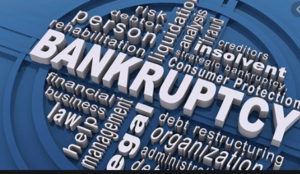What is Bankruptcy?
Bankruptcy is when an organization files a petition to the court when it’s unable to honor it’s financial obligations or make payment to its creditors. A petition is filed in the court for the same where all the outstanding debts of the company gets measured and paid out if not in full form the company’s assets.
Bankruptcy enables people who are unable to pay their debts to get a fresh start by liquidating assets in order to pay their debts or by creating a repayment plan. Bankruptcy laws also protect financially troubled businesses and help them stay in business.

Understanding Bankruptcy
Filing bankruptcy is a legal course that is undertaken by the company in order to free itself from debt obligations. Debts that are not paid to creditors in full are forgiven for the owners and bankruptcy filing differs in different countries.
In the United States, there are three main chapters 7, 11, and 13. We will be looking at them in detail.
Chapter 7
Secondly, an individual or an organization files for Chapter 7 under the US law in which they liquidate their assets in order to repay their debt obligations. When Chapter 7 of bankruptcy is filed, it means that all collection efforts from all creditors should be stopped at once.
Chapter 11
Furthermore, under the US Chapter 11 bankruptcy law implies that a company will attempt to restructure its debts to be able to meet the financial obligations. This particular bankruptcy code is for companies only and not for individuals. Chapter 11 depicts the intent of the company to pay off its debts which is a good sign. It offers them access to stay in business while trying to work out modalities in paying off the debts.
Chapter 13
Chapter 13 of the bankruptcy states that individuals will attempt to restructure their resources or cash flow in order to pay off debt. Individuals or self-employed persons can file for Chapter 13, however, corporations and partnership firms cannot.
Chapter 9
Municipalities – cities, towns, villages, taxing districts, municipal utilities, and school districts may file for bankruptcy under Chapter 9 to reorganize.
Chapter 12
This bankruptcy offers debt relief to family farmers and fishermen.
Chapter 15
Usually, bankruptcy filings is that which involves parties from more than one country.
Advantages of Going Bankrupt
The advantages of going bankrupt includes:
- It takes the pressure off you because you do not have to deal with your creditors.
- It enables you to keep certain things known as “exempt goods”.
- You are allowed to keep a reasonable amount from your income which you can live on.
- If you have to make payments from your income, it can only be for 3 years. You do not have to make payments if your only income is from welfare benefits.
- Creditors are mandated to stop most types of court action to get their money back following a bankruptcy order.
- You are not to pay back the debts that bankruptcy covers.
Disadvantages of Going Bankrupt
These disadvantages are:
- If you own a business and you go bankrupt, it might be closed down and the assets sold off.
- You may not be able to retain some jobs that do not allow people who have been made bankrupt carry on working.
- If you have a high enough income, you’ll be asked to make payments towards your debts for 3 years.
- You’ll have difficulties taking out credit while you are bankrupt and your credit rating will be affected for 6 years.
- If you own a home, it might be sold off. This depends on how much it’s worth after any amounts secured on it are repaid.
- If you are a tenant, your landlord could end your tenancy.
- You may have some of your possessions sold off if they are not “exempt goods”.
- You may have a bankruptcy restriction order filed against you which can last up to 15 years which will restrict your financial affairs.
- Bankruptcy will be publicly published (However if you are bothered that you or your family might be victims of violence, you can go to court to get an order so your address details are not given out).
- Filing for bankruptcy may affect your immigration status.
What Happens at the End of Bankruptcy?
Your bankruptcy will typically end after a year. This known as “Discharge”. After discharge, you are not required to repay the debts covered by it. However, you will still be required to pay some debts like court fines and loans from the Student Loans Company.
from WordPress https://ift.tt/3lq5OAQ
No comments:
Post a Comment